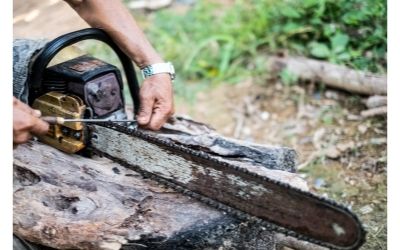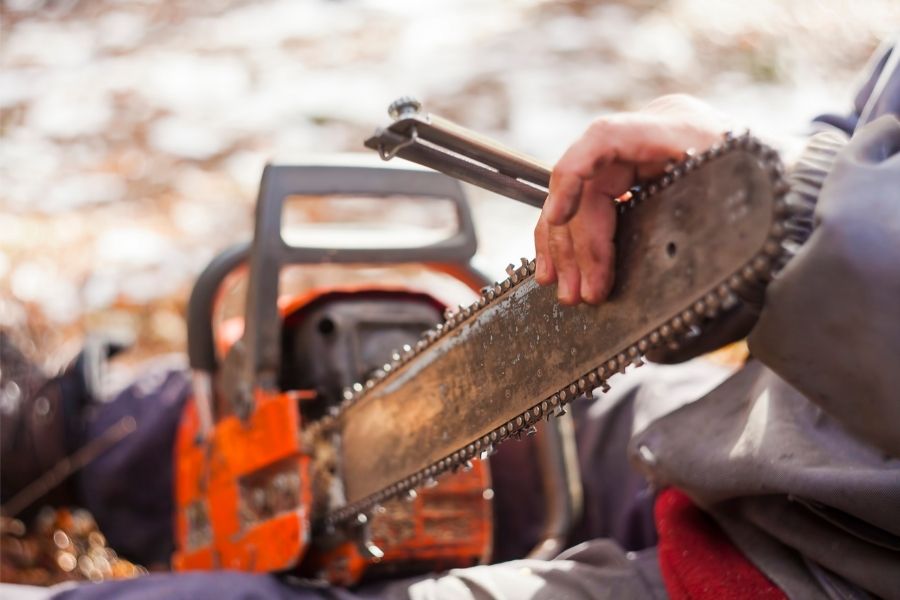 Feeling the power of that chainsaw in your hands has to be one of the most exhilarating things you will ever experience. Mostly it’s because of the power that the chainsaw holds and what it can do. To a lesser degree, you recognize the caution with which you should handle such a tool. At that moment, you aren’t thinking about how to sharpen chainsaw blades.
Feeling the power of that chainsaw in your hands has to be one of the most exhilarating things you will ever experience. Mostly it’s because of the power that the chainsaw holds and what it can do. To a lesser degree, you recognize the caution with which you should handle such a tool. At that moment, you aren’t thinking about how to sharpen chainsaw blades.
Lately, it hasn’t been as good to use the Chainsaw whenever you are working. It is becoming difficult to operate as the chain gets stuck in the wood. If anything, you feel as though you may need to apply a more directional force to get the blade through the wood.
This can be a dangerous position to be in as this indicates that the chainsaw is blunt. Rather than risk injury, it would be best to sharpen it. A blade becoming blunt is par for the course but there are few Woodcutting Tools that can accomplish the job of a chainsaw. Every piece of machinery that you use will experience wear and tear.
Before You Start

There are a few things you will need for this to be successful. The first of these are the tools you are going to use to do the sharpening. Before you even begin gathering the tools you will need, you will need to go through the manual that came with your chainsaw. If you do not have one, don’t worry. There are plenty of websites online that have the manuals you need.
The purpose of the manual is to help guide you on the proper diameter of your chainsaw. This will help determine which set of files to get. If you still don’t have a manual, then you can pick from three of the most popular diameters chainsaws are made with. These are 7/32 5/32 and 3/16 inches.
If you still aren’t sure, a quick visit to your local hardware store or a small engine dealer and you will get guidance from the staff.
While you are there, you will need to gather the following tools, if you don’t already have them. These include:
- A filing kit made specifically for chainsaws. This kit includes a depth gauge to help lower rakes, a flat file, a round file, and a file guide. You may be tempted to use a rattail file but this is highly discouraged.
- A pair of gloves. This helps to protect you from injury should you slip accidentally.

How to Sharpen Chainsaw Blades with a Hand File
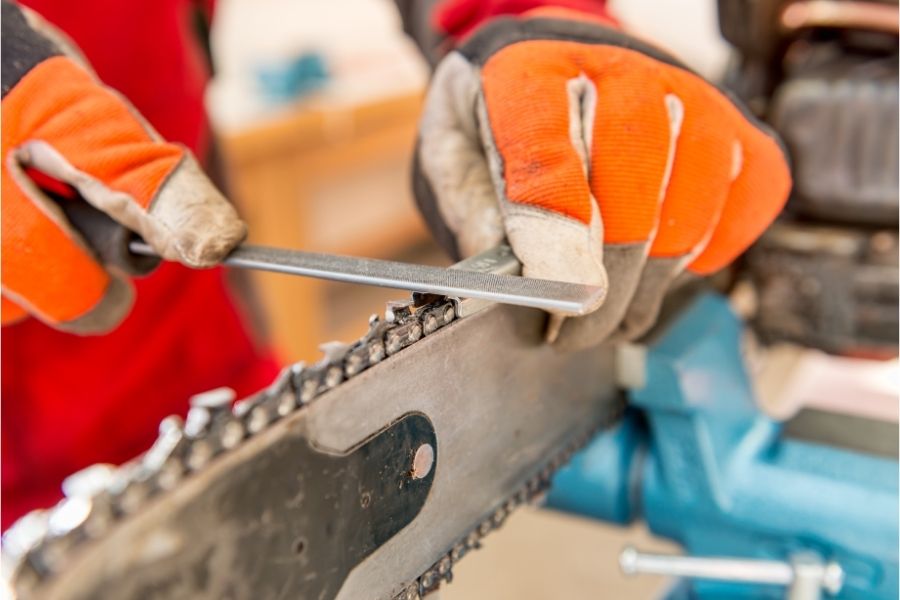 In this age of the self-driving car, it seems rather outdated to have to sharpen your chainsaw by hand. There are machines that are able to sharpen the blades quickly and easily. However, this just takes away the joy of working on your own tools and the feeling of getting things done.
In this age of the self-driving car, it seems rather outdated to have to sharpen your chainsaw by hand. There are machines that are able to sharpen the blades quickly and easily. However, this just takes away the joy of working on your own tools and the feeling of getting things done.
To sharpen the tool by hand, you will need to gather the tools you had put together. You will then need a proper work table on which to place the chain saw as you work on it. The saw has a double-sided design, meaning that there are blades facing either to the left or to the right if you look at the chainsaw lengthwise.
- To begin, engage the chain brake. This will stop the chain from slipping away from you as you work on it.
- Next, place the file guide in between the chain’s rivets. Place a round file in the guide as this is your best tool for sharpening the blades.
- The arrows on the guide should be pointing towards the bar.
- The cutter’s top plate should provide you with an angle that you can work with. This can be 30 to 40 degrees, depending on the model in question.
- Use steady strokes to file the cutters. This can be done in 3 to 5 strokes and are ready when you see the blades shining.
- After every five or six blades filed, release the chain’s brake and rotate it until you get new blades to work with.
- Repeat this process for the blades of the opposite direction.
How to Sharpen Chainsaw Blades with a Hand File – Step by Step Instructions
To assist you in this process, here are the steps to take with images.
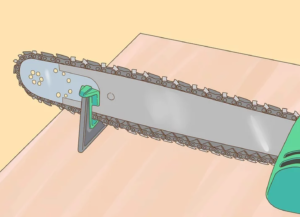
Step 1:
Use a tabletop clamp or a vise to hold the chainsaw in place on your work surface. This will prevent the saw from shifting as you sharpen it, and result in a much more consistent and easy sharpening process
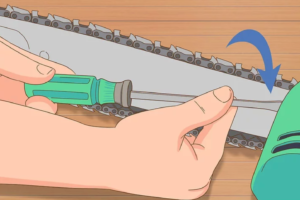
Step 2:
Find the tension adjusting screw on your chainsaw, usually perpendicular to the direction of the chain. Use a screwdriver to tighten the chain.
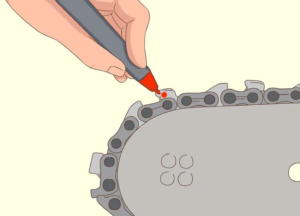
Step 3:
Choose the first tooth you’re going to sharpen. Color it in or mark it with a bright permanent marker so you can easily keep track of where you started and prevent you from sharpening the same section twice.
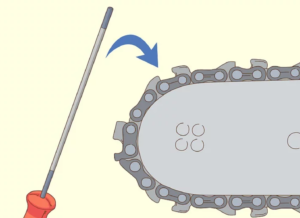
Step 4:
Different chainsaws have different sized teeth, and therefore will require different sized files to sharpen.
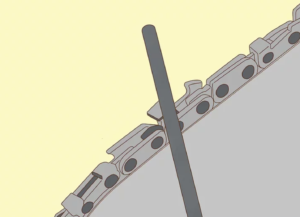
Step 5:
Place the tip of the file just inside the notch on the tooth you have marked so that roughly 20% of the file’s diameter is above the top of the tooth. The chain will have two types of cutters facing alternate directions. Choose one type of cutter to focus on first before moving onto the other type.
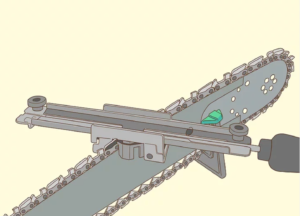
Step 6:
Some chainsaws will have lines etched into the top of each cutter to help guide your file at the appropriate angle. Line your file up so that it is parallel with this etching to set the proper angle. Usually the angle for filing will be either 25 or 30 degrees. Some may be flatter. Perhaps check the angle needed for your saw before beginning.
How to Sharpen Chainsaw Cutters
In the next step of this process, you’ll need to know how to sharpen chainsaw cutters.
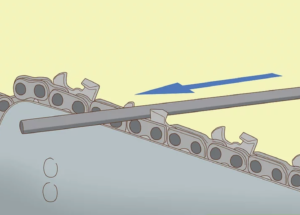
Step 1:
Hold the file so that it remains level and flat over the top of the chain. In one smooth motion, push the file through the cutter. You shouldn’t need to apply a lot of pressure, only enough so that you feel the file grinding against the cutter. Lift the file out of the cutter and reset it to the same place and at the same angle as it was previously
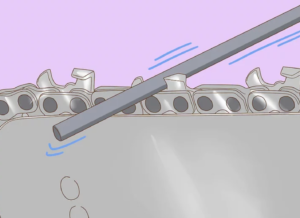
Step 2:
Repeat the exact same motion of running the file through the cutter until the cutter is a shiny, silver color and appears sharp. To ensure consistency across the sharpness of each cutter, count how many times you file the first cutter and file each subsequent cutter the same number of times.
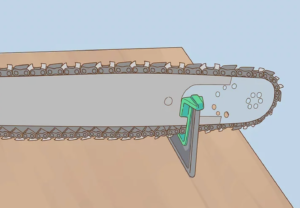
Step 3:
Loosen your vise or clamp and rotate the chainsaw 180 degrees. This reveals the alternate cutters that you skipped sharpening in the first loop around the chain and means you don’t need to change your stance or method.
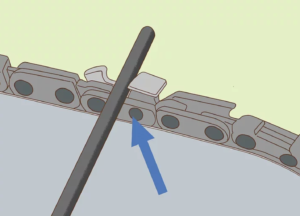
Step 4:
Move around the chain again, sharpening each tooth that has not yet been sharpened. Make sure to use the same amount of pressure and run the file through the same amount of times in order to keep each cutter consistent and level
How to File the Rakers on a Chainsaw
The next step in sharpening chainsaw blades is to file the rakers. The rakers are the bumps along the chain in between each cutter. They function to keep the depth of the cut consistent as the chain spins around the saw, so making sure each is level is very important.
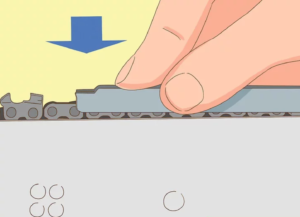
Step 1:
Set the depth gauge over the chain near your starting point and push it forward until it presses against a raker
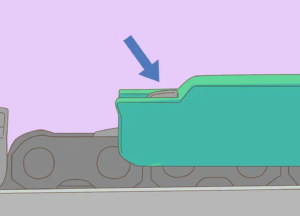
Step 2:
Check whether or not the top of the raker sits higher than the top of the depth gauge. If it does, it will need to be filed down. If not, move the gauge forward to the next raker until you find one that does.
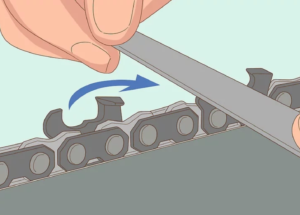
Step 3:
Continue the same process of checking rakers with a depth gauge and filing them down all the way around the rest of the chain. Unlike the cutters, you don’t need to worry about filing the same raker twice as you are filing the rakers down.
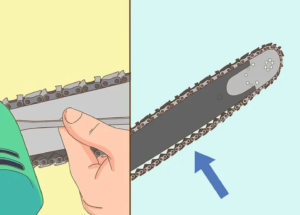
Step 4:
Use the adjustment screws to loosen the chain of your chainsaw back to a usable tension. Loosen the clamp or vise holding the chainsaw in place and take the chainsaw out. Your chainsaw should now be sharpened evenly and ready to use.
How to Sharpen a Chainsaw Blade by an Electric Sharpener

Well, it definitely wouldn’t be the 21st century if there was no way to sharpen the blades electrically. If you are looking to get your blade in shape quickly, this is the best way to go.
- You will need to properly mount the sharpening tool on a steady platform. This could be a workbench or even on the ground. Next, you will need to get both the gauge and the pitch with which to sharpen the blades.
- Place the blade onto the sharpener and find the best angle to work with. Some blades require angles of up to 60 degrees while others can go beyond that to 80 degrees.
- You will then need to account for the depth of the blade. This is to stop the grinder from damaging the blade.
- Fire up the grinder and then slowly set it against the blade. Put them in gentle contact for a few seconds and then lift to check whether the blade has been sharpened. The blade will usually be shiny if well done. Repeat this process for all the other blades on that side of the saw. Once you are done, you will need to repeat this process from the second step, this time for the other side of the saw.
How to Pick Arborist Chainsaws

Chainsaws are incredibly useful tools. Their proliferation all over the land hasn’t been without reason. This has meant manufacturers have found different ways to meet the demand. This has mostly been by providing the market with different types of chainsaws.
As an arborist, you may be wondering what is out there for you that fits your unique working requirements, and experience. Well, here are a few things to consider when choosing your next chainsaw.
- Safety features: It is no secret the kind of horror injuries that are caused by a mishap with a chainsaw. As an arborist, you don’t want to end up in the hospital for something that was preventable, to begin with.
- Source of power: The kind of power source you choose will determine how you work. If you are just looking to engage in hobby sawing, a battery-powered saw might work. If just for some woodwork around the home, or an outdoor workplace, a corded electric would work best. If you are going out to the woods, then a gas-powered saw would work best for you.
- Length of guide bar: In general, the lengthier the guide bar, the more powerful that saw is. For cutting through huge trees, a guide bar of 16 to 24 inches would work best. If you are looking at cutting narrow pieces, a guide bar less than eight inches would work best for you.
Interested in other types of blades? You may want to check out our article on Bandsaw Blades for Resawing
